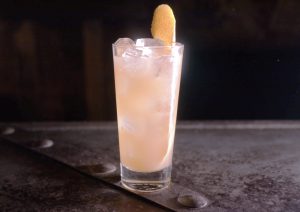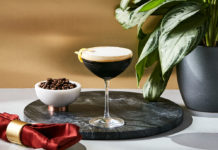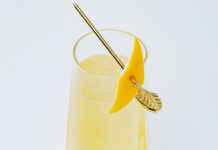 In part two of our Q&A series on bartenders focused on sustainability, we talk with Aaron Polsky, Bar Manager of Harvard & Stone in Hollywood, California. “Sustainability is the biggest buzzword of 2017 in the bar world. Everybody’s trying to look for ways to do it,” he says. “There’s the reuse of products; an awareness of wasting ice, water, energy, etc; and an awareness of packaging.” Polsky’s experience working in restaurants, a stint at Cordon Bleu in Paris, and a general love for food and cooking, has led him to experiment with creating new concoctions out of typically discarded ingredients. “I think the biggest challenge is not knowing how it will come out on the other end,” he says. Polsky has also created sustainable cocktails as a guest bartender at the pop-up wastED London, which is a community working together to reconceive “waste” that occurs at every link in the food chain.
In part two of our Q&A series on bartenders focused on sustainability, we talk with Aaron Polsky, Bar Manager of Harvard & Stone in Hollywood, California. “Sustainability is the biggest buzzword of 2017 in the bar world. Everybody’s trying to look for ways to do it,” he says. “There’s the reuse of products; an awareness of wasting ice, water, energy, etc; and an awareness of packaging.” Polsky’s experience working in restaurants, a stint at Cordon Bleu in Paris, and a general love for food and cooking, has led him to experiment with creating new concoctions out of typically discarded ingredients. “I think the biggest challenge is not knowing how it will come out on the other end,” he says. Polsky has also created sustainable cocktails as a guest bartender at the pop-up wastED London, which is a community working together to reconceive “waste” that occurs at every link in the food chain.
1 Tell me about Harvard & Stone.
We‘re a hybrid of cocktail bar, music venue, and neighborhood dive bar. We have immensely talented bartenders who are also extremely casual and relatable. In a way, we’re also a whiskey bar. Physically, the menu’s actually music focused as it’s printed on a seven-inch, gatefold LP cover. In terms of drinks, the idea of the menu was to try to put together something that was creatively compelling and as reflective of our staff as possible. I change it a couple times a year. The printing of the menu itself is a bit restrictive on that because the printing and the design takes a few weeks. But that said, our R&D bar in the back has a menu that changes daily. Whoever works it—six nights a week it’s staff, and one night a week it’s a guest bartender—writes a new menu for original cocktails. So since we’ve opened, we’ve had somewhere in the neighborhood of 9,000 original cocktail recipes in our R&D bar.
2 What led you to start using ingredients that would otherwise be discarded?
When I first did it, I was at Mulberry Project in New York. I wanted to see how we could reduce waste and turn things that are unusable in their current, tired state into something usable. For example, back then, I would take something like old lime juice and cook it down with sugar and old lime wedges and basically make a marmalade syrup. The sugar would bring up the boiling point so you could get a higher temperature liquid while you’re cooking. I would do it with lemon as well. Two-day old lime juice doesn’t taste good and brown-edged lime wedges don’t look good, but when you cook it all together and make this marmalade, you’re making something that’s as it should be.
3 What are some of the other things you’ve made using typically discarded ingredients?
I would say one of the most interesting things that I’ve done is take lemon juice and lemon wedges and ferment them with probiotics. I wanted to save fossil fuels because to save a waste product by consuming resources is kind of a dubious achievement. So I did an 80%
lemon juice, 20% sugar base, and the sugar was basically to make the environment more hospitable for the bacteria. I went to GNC, opened up a few probiotics into it, and let it sit in a sealed container. A week later, it almost packed the pungency of a ginger beer. The lemon oils that just incidentally get into the juice when you squeeze the lemon popped
to the forefront. It really got this pungent, almost back of the throat tang like ginger beer has—almost a spiciness. I’ve done it with lime as well but using lime and molasses. We make a mule with it. I’ve purchased a few fermentation buckets to enable large scale of this, and the idea is to use it in our keg cocktails.
4 Do you have any advice for other bar managers looking to be more mindful of waste?
I think that in any context the most conscientious approach to not wasting fresh ingredients is to figure out an end destination for them when they are no longer good in their original state. So with lemon juice or cucumber slices, think about what you can do with these when they’re no longer good. With lemon juice, you can make a cordial or a syrup, you can turn them into a sorbet of sorts, you can use fermentation methods.
With garnishes, one of the easiest things is to soak them in sugar, make syrups, and use that syrup in a cocktail that’s on your menu. You want a menu application for it so it’s  ordered frequently. If it’s used as a menu syrup, then you’ll find that those garnishes will turn into a small percentage of the actual product that you’re using.
ordered frequently. If it’s used as a menu syrup, then you’ll find that those garnishes will turn into a small percentage of the actual product that you’re using.
View Polsky’s Tequila Grapefruit recipe.
Photos: Max Shapovalov; (cocktail) Aaron Polsky.








